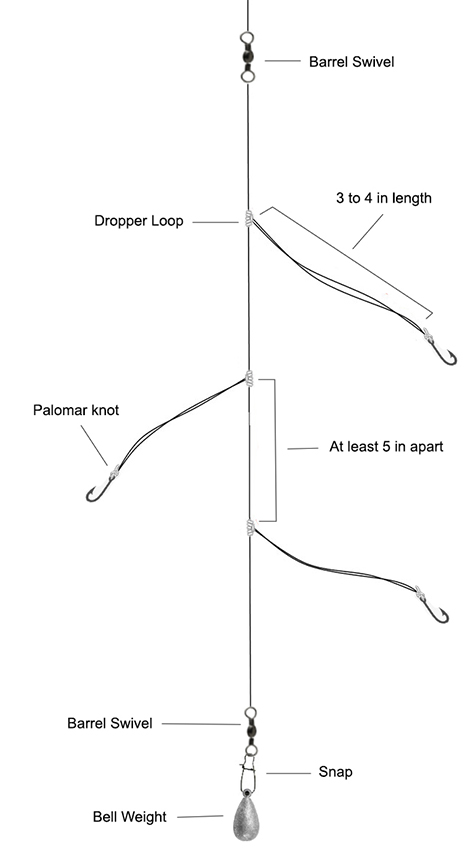The paternoster rig, commonly referred to as a chicken rig or dropper rig, is a versatile multi-hook bottom fishing rig used to catch a variety of fish species found in deeper offshore coastal waters. It is particularly productive for targeting fish that hold close to the sea floor or near structure. It’s a great rig for catching species such as snapper, grouper, kingfish, and cod that inhabit reefs, rocky shorelines, and deep water structures.

The paternoster rig is best fished from an anchored boat. Any slack in the line should be taken in so biting fish don’t sense the resistance of the sinker and release the bait before a solid hookset is achieved.
How to Tie the Paternoster Rig
Creating a paternoster rig is simple and straight forward.
Add one to three 3″-4″ dropper loops with hooks to your main line spaced at least 5″-8″ apart. You want to make sure you leave enough space between each loop so they don’t tangle. The combined length of the loops should be shorter than the distance between them. The dropper loops are created in the leader line be creating a standard dropper loop knot.
Hooks are attached to each dropper loop using a cow hitch. Using the cow-hitch approach allows you change out hooks quickly and easily. For better catch rates, use circle, octopus, or wide gap hooks. Fishing with circle hooks will produce less damage to the fish and makes release easier. Wide gap hooks tend to hold fish better than old school J hooks but are typically only available in medium to light wire strengths.
Beneath the loops attach a sinker to the end of your leader. The sinker ensures the rig will sink and stay on or near the bottom. You want to use the lightest weight you can get away with. The sinker can be attached to the leader using a barrel swivel and snap—or snap swivel. Using a snap swivel will allow you to change your sinker weight as needed. Alternatively, you can tie a loop at the end of the line which you’ll thread through the eye of the weight and then back up around the neck of the weight.
At shallow depths, use a lighter 2-4oz weight. At medium depths, use a 4-6oz weight. For deeper water, we recommend a weight between 6 and 8oz. The weight of your sinker will be determined by fishing depth and water conditions. Stronger current will require a heavier sinker in order to secure your rig in place on the bottom near structure.
Attach the completed paternoster rig to the main line using a #7-8 barrel swivel. When using heavier line or targeting larger fish, you can upsize your swivel to #1-2/0. The best knots for attaching swivel to line are the a palomar, uni or improved clinch knot.
One of the downsides of a traditional paternoster rig is the double line profile the dropper loops create. The loops are highly visible and may scare off some fish. The double line profile can be fixed by snipping off part of the dropper loop close to the knot, leaving only a single line. However, this can lead to twists and tangles. A variant of the paternoster, the flapper rig, is another alternative that provides a lower profile but is not as prone to tangles.
Paternoster Rig for Surf Fishing
While traditionally an offshore fishing rig, the Paternoster is also effective for fishing nearshore estuaries and bays, as well as right off the beach. Its ability to present multiple baits at the same time and low propensity for line tangles make it an effective surf fishing rig. When surf fishing, a sinker in the 3-4oz range will provide sufficient casting distance while holding bait in place on the bottom.



